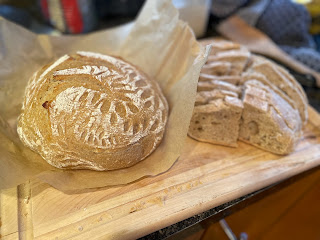sourdough bread
Making sourdough bread takes a while. But, it's worth it... when it turns out.
I've been learning a lot about patience lately. We live in a world of instant gratification, and I think it very beneficial to the soul to put in the work for a day or two before you get your perfect loaf of bread. It's by no means as convenient as going to the store and buying a loaf for $5.99, but where is the joy or accomplishment in that!? Well, I'll give it to you, it is worth it sometimes to pay for convenience. But anyways, if you want to do it yourself, here are some tips.
Remember, Jesus is the bread of life, and as you make bread, think of all the ways bread-making correlates to your faith walk. I'm going to leave this very open-ended. Just think about it, and see what you come up with. Happy thinking! And happy bread-making! Perhaps I'll share my list of correlations at some point.
Let's start with a recipe.
If you know me, I don't use recipes, so this means a lot. It's a good one.
Here is a link to my favorite sourdough recipe. The directions are very clear, and even as someone who almost never follows recipes, I recommend using one for sourdough bread... at least when you're starting out. That doesn't mean you can't deviate a bit, but I recommend starting simple and building from there.
One important aspect of sourdough bread-making is learning how to do a "stretch & fold." Sounds fancy, but it isn't hard. Click here for instructions on how to do that.
The stretch & fold is super important. It's sort of like kneading normal bread dough, but it gives your dough that fluffy texture and the air-filled pockets. I stretch and fold my dough about every 30 minutes for 3-4 hours after making my dough. It doesn't have to be an exact 30 minutes between each time - do it when you're able to take three minutes away from whatever else you're doing, because let's be real: you're not going to drop all other commitments to only make a loaf of bread. If you like efficiency as much as I do, you'll realize you can let sourdough bread-making be something going on in the background of life.
If you're pulling your starter out of the refrigerator (you only need to feed it about once a week if you keep it in ther fridge, because the temperature of the fridge slows the fermentation process), I recommend feeding your starter in the evening, feeding it again the next morning, and then using your active starter mid-afternoon.
If you start your bread mid-afternoon, you can be done with your stretching and folding by bedtime. Then I put my dough (covered) in the fridge overnight to let it rise and ferment a little more. Again, the process slows down in the fridge, so it'll be okay for at least 12 hours overnight. I tried starting bread in the morning and baking it in the evening once... and it just wasn't the same. Let's just say good sourdough DOES happen overnight!!
When you pull it out of the fridge the next morning, do one more gentle stretch and fold. Then, shape your dough into a final loaf shape. This is where I sometimes add fun things like cheese and garlic or raisins and cinnamon for a more exciting loaf. Put your final shape on a piece of parchment paper and let it sit in a bowl so that it holds the shape while you let it sit on the counter and rise one last time (about an hour). Don't forget the parchment paper. If you simply bake it in your dutch oven without it, you'll end up with a loaf that sticks and burns to the bottom of your dish. You also want it to be room temperature when you start baking it.
Heat up your oven - WITH dutch oven inside. If you don’t have a dutch oven, it's literally one of my very favorite kitchen things. Totally worth the buy. I use it ALL the time. Soup, popcorn, roast, literally everything. And of course, sourdough bread.
When you use one of these (with the lid) it mimics a steam oven, so you’re able to get the crispy outside and the soft inside of the classic sourdough loaf. Once you’ve warmed up your dutch oven, transfer the parchment paper AND the loaf into the hot dutch oven. You can score your loaf in this step or with your final shape. Just don't burn your hands on the hot dutch oven. Do put at least one good slit in the top of your loaf to let steam out of your loaf. Then, use the recipe instructions (see link above) for how long to bake it!
I like mine a little extra golden brown and crispy on the outside, so I go a little longer than the recipe calls for. Bake it with the lid, then finish it off without the lid. Then you can pull the parchment paper with the loaf out of your dutch oven and onto a cooling rack, and there you have it!! It's better when you don’t cut into it right away, but sometimes I do anyways.... because it’s warm bread and… why not!? :)
Here's one more link for you (I haven’t tried a lot of these recipes, but I’d love to!):
And finally, this is my favorite discard recipe - perfect for breakfast or a snack anytime during the day. I like using discard recipes because I don’t like throwing away any of my starter… and out comes my inner Dutch. Don't waste food. Top this recipe with a little maple syrup or a few berries... and keep it in the fridge after you make it for a quick on-the-go snack or breakfast that's way better (and cost-effective) than a granola bar or something packaged.
_____________
"For the bread of God is the bread that comes down from heaven and gives life to the world." ~ John 6:33
__________



